How Safe is a Motorcycle?
How safe is motorcycling? How does it compare to driving an automobile? Are there any special precautions to be observed? What are the causes of motorcycle crashes and how can crashes be reduced?
This Web site will:
- answer your questions about safe motorcycling;
- point out the risks involved in motorcycling;
- provide safety tips on protective clothing, defensive driving, inspection and maintenance, and proper reaction to hazardous conditions.
Background:
There are over 4 million motorcycles registered in the United States. The popularity of this mode of transportation is attributed to the low initial cost of a motorcycle, its use as a pleasure vehicle and, for some models, the good fuel efficiency.
Motorcycle fatalities represent approximately five percent of all highway fatalities each year, yet motorcycles represent just two percent of all registered vehicles in the United States. One of the main reasons motorcyclists are killed in crashes is because the motorcycle itself provides virtually no protection in a crash. For example, approximately 80 percent of reported crashes result in injury or death; a comparable figure for automobiles is about 20 percent.
An automobile has more weight and bulk than a motorcycle. It has door beams and a roof to provide some measure of protection from impact or rollover. It has cushioning and airbags to soften impact and safety belts to hold passengers in their seats. It has windshield washers and wipers to assist visibility in the rain and snow. An automobile has more stability because it's on four wheels and, because of its size, it is easier to see. A motorcycle suffers in comparison when considering vehicle characteristics that directly contribute to occupant safety. What a motorcycle sacrifices in weight, bulk, and other crash-worthiness characteristics is somewhat offset by its agility, maneuverability, and ability to stop and swerve quickly when necessary.
Driving Tips
Be Courteous: The practices of some riders are offensive to other motorists (e.g., weaving in and out of stalled traffic, riding on the shoulders). Being inconsiderate of other motorists creates a negative image for all riders and can cause crashes.
Follow these rules:
- treat other motorists with courtesy and respect;
- avoid tailgating;
- avoid riding between lanes of slow moving or stopped traffic;
- know and obey traffic laws, including ordinances in your community;
- avoid excessive noise by leaving stock muffler in place or using a muffler of equivalent noise reduction;
- use signals when appropriate.
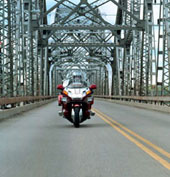 Drive Defensively: Be especially alert at intersections because approximately 70 percent of motorcycle-vehicle collisions occur there! Watch for vehicles that may unexpectedly turn in front of you or pull out from a side street or driveway. At intersections where vision is limited by shrubbery, parked vehicles, or buildings, slow down, check for traffic and be prepared to react quickly.
Drive Defensively: Be especially alert at intersections because approximately 70 percent of motorcycle-vehicle collisions occur there! Watch for vehicles that may unexpectedly turn in front of you or pull out from a side street or driveway. At intersections where vision is limited by shrubbery, parked vehicles, or buildings, slow down, check for traffic and be prepared to react quickly.
Check the rearview mirrors before changing lanes or stopping. A quick stop without checking rear traffic may result in a rear-end crash. When changing lanes, use signals and make a visual check to assure that you can change lanes safely.
Watch the road surface and traffic ahead to anticipate problems and road hazards. Road hazards that are minor irritations for an automobile can be a major hazard for a rider. Hazards include potholes, oil slicks, puddles, debris or other objects on the roadway, ruts, uneven pavement and railroad tracks. Painted roadway markings and manhole covers can be extremely slippery when wet.
Go around most hazards. To do so safely, you must be able to spot such hazards from a distance. Slow down before reaching the obstacle and make sure you have enough room before changing direction. Railroad tracks should be crossed at an angle as close to 90 degrees as possible.
Experienced motorcyclists often have this advice for new riders: "Assume that you are invisible to other motorists and operate your motorcycle accordingly."
Position yourself to be seen. Ride in the portion of the lane where it is most likely that other motorists will see you. Avoid the car's "No Zone" (i.e., blind spot). All motor vehicles have blind spots where other vehicles cannot be seen with mirrors. These blind spots are to the left and right rear of the vehicle. Do not linger in motorists' blind spots.
Use your headlights, day and night.
Wear brightly colored, preferably fluorescent, clothing. Use retro-reflective materials on clothing and motorcycle, especially at night.
Maintain a safe speed consistent with driving conditions and your capabilities. Gravel on the road and slippery road surfaces can be hazardous. Avoid sudden braking or turning.
When riding in the rain, riders find they get better traction by driving in the tracks of vehicles in front of them. But avoid following too closely, and riding on painted lines and metal surfaces such as manhole covers, because they offer less traction.
If caught in a sudden shower while riding, pull off the highway under some shelter (e.g., overpass) and wait for the rain to stop. If you must ride in the rain, remember that conditions are most dangerous during the first few minutes of rainfall because of oil and other automobile droppings on the roadway. If possible, sit out the beginning of a rain shower.
Don't tailgate, and don't let other drivers tailgate you. Following too closely behind another vehicle may make it difficult for you to brake suddenly. Further, you won't have time to avoid road hazards and traffic situations ahead. If another vehicle is following too closely, wave it off with a hand signal or tap your brake pedal. If they continue to follow too closely, change lanes or pull off the road and let them pass.
Pass only when it is safe to do so. Do not pass or ride on the shoulder. Pull over to the left third of the lane before passing and make sure that you are at a safe following distance. Use turn signals and avoid crowding the other vehicle as you pass. Remember to always check for traffic before changing lanes.
Use brakes wisely. Use both brakes together. Brake firmly and progressively and bring the motorcycle upright before stopping. Remember that driving through water can adversely affect the brakes. After passing through water, look for following traffic and, when safe to do so, check your brakes by applying light pressure.
Dogs can be a problem for riders. Don't become distracted and don't kick at a dog. As you approach a dog, downshift, when you reach the dog, accelerate quickly away.
Safety Tips
Safety Tips for Motorists and Motorcycle Operators to Safely Share the Road
Car and truck drivers are urged to:
- be aware of cyclists. After winter, drivers are not accustomed to seeing motorcycles, mopeds and bicycles on the roads;
- share the road. Motorcyclists are entitled to a full lane of traffic, just like another car or truck. Moped and bicycle riders must stay to the right and share a lane;
- keep a safe distance from the cycle. Because of road hazards or other traffic conditions, cyclists may have to swerve or stop suddenly;
- check your blind spots before turning, changing lanes, backing up or parking. Many traffic crashes occur because a driver did not check or see the cyclist;
- be extra alert for motorcycles, mopeds and bicycles at or near intersections. They are easily overlooked, if traffic is heavy, or the driver is in a hurry. Pay particular attention when making left turns across traffic, to insure that a cyclist may not be coming straight through;
- use extreme care in passing. Because of the smaller size of a bike, a car or truck passing too fast or too close could blow the cyclist out of control. In addition, a vehicle passing too close, could throw stones or other road debris at the cyclist.
Motorcycle operators are urged to:
- keep in mind that weather conditions, road surfaces and fatigue pose greater problems for cyclists than other motorists;
- a properly fitting helmet, gloves and boots provide the best protection from serious injury;
- wear brightly colored clothing so other drivers see you. Operation of the cycle's headlight (standard on later model cycles), also increases the visibility of the cycle;
- assume the driver of the other vehicle does not see you. Always be prepared to take evasive action. Drive defensively;
- ride near the center of the lane. Stay out of other drivers' blind spots;
- when riding in a group, do not ride two abreast in a single lane. Ride in a staggered formation, allowing a safe distance to maneuver in an emergency;
- avoid excessive speed when operating the cycle. Slow down at night and during inclement weather, when visibility is usually reduced;
- avoid alcoholic beverages when operating the cycle;
- keep your motorcycle in good operating condition, using the safety and maintenance checks listed in the owner's manual as a prevention guide.
T-CLOCS - Pre-ride Checklist
T - Tires and wheels
- tire conditions -- tread depth, weathering, bulges, imbedded objects and uneven wear;
- air pressure -- check cold, normal loss is a pound or two a week;
- spokes -- check for bent, broken or missing ones;
- rims -- out of round and out of true;
- wheel bearings -- no free play and no growl when spinning.
C - Cables and controls
- throttle, clutch and brake cables -- correct free play, smooth operation, no fraying;
- shifter -- securely mounted, operates smoothly;
- brakes -- operate smoothly, don't drag excessively, pads greater than minimum thickness;
- kill switch -- shuts off engine when moved to the off position.
L - Lights and electronics
- battery -- terminals tight and clean, water level okay, secured, proper routing of breather tube;
- wiring -- none frayed or pinched, especially important at steering head;
- switches -- make sure all operate correctly (kill switch, brakelights, headlights, signals, horn);
- lighting -- check all light bulbs (headlights, tail/brakelights, markers, turn signals and instruments);
- horn -- proper mounting and ensure it works.
O - Oil and fuel
- leaks -- visually check for leaks (coolant, hydraulic brakes/clutch, engine oil, forks, final drive);
- levels -- check oil level on center stand when cold;
- air filter -- no blockage, clean, not torn;
- fuel lines -- not bent, leaking/cracked, properly secured with clamps;
- hydraulic fluid -- correct levels, no leakage, no hose deterioration.
C - Chain and chassis
- chain/belt wear and tension -- proper adjustment, lubricated, check master link clip;
- sprockets -- check for wear;
- chain guard -- securely mounted;
- foot pegs -- should fold up, securely mounted;
- steering head bearings -- no detent in middle, no binding, smooth operation;
- swing arm bushings -- check for movement at swing arm pivot;
- accessory mounts -- secure, no missing bolts, no interference with steering/suspension;
- cotter pins and clips -- no missing clips, check where mechanical cables attach;
- frame -- check for cracks, problems with accessory mounts, steering head, engine cradle;
- shocks and forks -- check for leaks, smooth operation, air pressure, alignment.
S - Stands
- side stand -- not bent, retracts fully, spring has tension, proper ground clearance;
- center stand -- not bent, retracts fully, spring has tension, proper ground clearance.
Causes of Motorcycle Crashes
Motorcycle crashes can be caused by or attributed to:
- lack of basic riding skills;
- failure to appreciate the inherent operating characteristics;
- failure to appreciate the limitations of the motorcycle;
- failure to use special precautions while riding;
- failure to use defensive driving techniques;
- lack of specific braking and cornering skills;
- failure to follow speed limits.
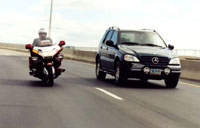 A motorcyclist should attend a motorcycle RiderCourse to learn how to safely and skillfully operate a motorcycle. A motorcyclist has to be more careful and aware at intersections, where most motorcycle-vehicle collisions occur. Motorcyclists must remain visible to other motorists at all times. Don't ride in a car's "No Zone" (blind spot). Anticipate potential dangers more than other vehicle drivers do. For example, anticipate that drivers backing their cars out of driveways may not see you. Place greater emphasis on defensive driving.
A motorcyclist should attend a motorcycle RiderCourse to learn how to safely and skillfully operate a motorcycle. A motorcyclist has to be more careful and aware at intersections, where most motorcycle-vehicle collisions occur. Motorcyclists must remain visible to other motorists at all times. Don't ride in a car's "No Zone" (blind spot). Anticipate potential dangers more than other vehicle drivers do. For example, anticipate that drivers backing their cars out of driveways may not see you. Place greater emphasis on defensive driving.
Motorcyclists also must be more cautious when riding in inclement weather, on slippery surfaces, or when encountering obstacles on the roadway. They must place greater reliance on their helmet, eye protection and clothing to increase riding comfort and to reduce the severity of injury should they become involved in a crash.
Approximately half of all fatal, single-vehicle motorcycle crashes involve alcohol. A motorcycle requires more skill and coordination to operate than a car. Riding a motorcycle while under the influence of any amount of alcohol significantly decreases an operator's ability to operate the motorcycle safely.
An estimated 33 percent of motorcycle operators killed in traffic crashes are not licensed or are improperly licensed to operate a motorcycle. By not obtaining a motorcycle operator license, riders are bypassing the only method they and state licensing agencies have to ensure they have the knowledge and skills needed to operate a motorcycle safely.
Buying the Right Motorcycle
A motorcycle should be selected for a comfortable fit and functional requirements:
- select a motorcycle that fits. A motorcyclist should be able to touch the ground with both feet when astride the vehicle;
- if you will be carrying a passenger, make sure the motorcycle you select has a passenger seat, as well as, foot rests (foot pegs) for the passenger;
- check the location of the controls. Make sure you can reach and operate them easily and comfortably.
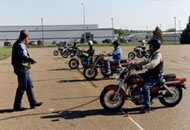 Functional Requirements:
Functional Requirements:
Buy the power you need, but only as much as you can handle safely. Large motorcycles are heavy, and you must be strong enough to push it, or pick it up if it falls over. But smaller bikes (e.g., a 125-cc machine) may not have the speed, performance and ride you'll need, if you plan to travel long distances.
Consider the primary use of your bike. Don't buy a "trail" bike for highway use. Similarly, don't buy a "highway" bike if most of your riding will be off the road. Some motorcycles are built especially for trail use, with special tires and suspension. Other motorcycles have special characteristics for highway use, such as tires designed to grip pavement, and more powerful braking systems. If you have dual requirements, combination cycles are available that make a compromise between road and trail riding.
After You Buy, But Before You Ride:
- the safe operation of a motorcycle requires different skills and knowledge than is needed for a passenger car
- never ride without a certified motorcycle helmet and eye protection
- insist on a helmet that has an U.S. Department of Transportation (DOT) label
- read your owner's manual thoroughly
- use it to get familiar with your motorcycle
- attend a motorcycle RiderCourse
- it is the best way to learn how to operate a motorcycle safely and skillfully. RiderCourses provide unique knowledge and skills that you may not learn, if a friend teaches you how to ride
- wear the right shoes, gloves and clothing
- thick, protective clothing, shoes and gloves, not only provide comfort against the elements, but provide the extra protection needed in a crash.
Before Riding in the Street
After completing a motorcycle RiderCourse, practice before going out on the street.
Depending on what type of cycle you have, find an off-highway area or vacant parking lot and practice until use of all controls becomes automatic and you become thoroughly accustomed to requirements for balance, making turns, stopping and shifting.
Remember that a motorcyclist must abide by the same traffic rules and regulations as other motorists. Before taking your motorcycle on a public road, become familiar with traffic rules and regulations and any special requirements for motorcycles.
Be aware that riding with a passenger requires even more skill than riding alone. Riding with a passenger should be delayed until you have considerable solo riding time and are ready to take on the responsibility of carrying a passenger.
Obtain your learner's permit or motorcycle endorsement on your driver's license before you venture onto the streets. You will be required to display the knowledge and skill needed to operate a motorcycle safely before issued a motorcycle operator's license.
Never drink and ride.
Alcohol slows reflexes and greatly limits your ability to operate a motorcycle. Even a very small amount of alcohol can reduce your ability to operate a motorcycle safely.
Protective Clothing and Equipment
Studies show that the head, arms and legs are most often injured in a crash.
Protective clothing and equipment serve a three-fold purpose for motorcyclists: comfort and protection from the elements; some measure of injury protection; and through use of color or reflective materials, a means for other motorists to see the motorcyclist.
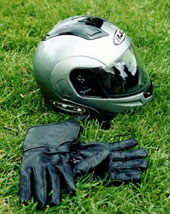 Helmet:
Helmet:
This is the most important piece of equipment. Safety helmets save lives by reducing the extent of head injuries in the event of a crash. Many good helmets are available. Make sure it fits comfortably and snugly, and is fastened for the ride. In choosing a helmet, look for the U.S. Department of Transportation (DOT) label on the helmet. The DOT label on helmets constitutes the manufacturer's certification that the helmet conforms to the federal standard. In many states, use of a helmet is required by law. Passengers should also wear a helmet.
A consumer information brochure on how to choose and care for a motorcycle helmet is available from the National Highway Traffic Safety Administration, 400 Seventh Street, SW, NTS-22, Washington, DC 20590 or by selecting the topic "Motorcycle Safety" and then selecting item number 6P0010http://www.nhtsa.dot.gov/people/outreach/media/catalog/index.cfm.
Gloves:
Durable gloves are recommended. They should be of the non-slip type to permit a firm grip on the controls. Leather gloves are excellent, as are special fabric gloves with leather palms and grip strips on the fingers. Gauntlet-type gloves keep air out of the rider's sleeves. Appropriate gloves are available for all types of weather.
Eye Protection:
Since many motorcycles don't have windshields, riders must protect their eyes against insects, dirt, rocks or other airborne matter. Even the wind can cause the eyes to tear and blur vision, and good vision is imperative when riding. Choose good quality goggles, glasses with plastic or safety lenses, or a helmet equipped with a face shield. Goggles, glasses and face shields should be scratch free, shatter proof and well-ventilated to prevent fog buildup. Only clear shields should be used at night since tinted shields reduce contrast and make it more difficult to see. Even if your motorcycle has a windshield, eye protection is recommended.
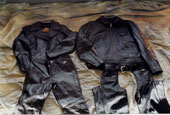 Jacket and Trousers:
Jacket and Trousers:
Clothing worn when riding a motorcycle should provide some measure of protection from abrasion in event of a spill. These should be of durable material (e.g., special synthetic material or leather). Jackets should have long sleeves. Trousers (not shorts) should not be baggy or flared at the bottom to prevent entanglement with the chain, kick-starter, foot pegs or other protrusions on the side of a motorcycle.
Note: Upper body clothing should be brightly colored. Some riders wear lightweight reflective orange or yellow vests over their jackets. Retro-reflective material used on clothing, helmet and the motorcycle helps to make the rider visible to other motorists, especially at night. A high percentage of motorcycle-vehicle crashes occur because the driver of the vehicle "failed to see the rider in time to avoid the crash."
Footwear:
Proper footwear offers protection for the feet, ankles and lower parts of the legs. Leather boots are the best. Durable athletic shoes that cover the ankles are a good second choice. Sandals, sneakers and similar footwear should not be used since they provide little protection from abrasion or crushing impact. Avoid dangling laces that can get in the way.
Preventative Maintenance
Read the owner's manual from cover to cover. It tells you how to operate your motorcycle, maintain it and diagnose problems.
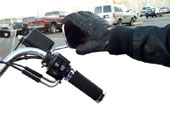 Carry the owner's manual and recommended tools and spare parts on your motorcycle. Adhere closely to the manufacturer's recommended maintenance schedule.
Carry the owner's manual and recommended tools and spare parts on your motorcycle. Adhere closely to the manufacturer's recommended maintenance schedule.
Before each day's riding, perform a visual and operational check of the motorcycle and its operating systems. Check lights, turn signals, tires, brakes, fuel and oil levels, mirrors and control cables. Replace broken, worn or frayed cables at once. Lubricate and adjust your chain as prescribed in your owner's manual.
Riders must ride aware, know their limits and ride within them. They must also be aware of and understand their motorcycle's limitations and the environment in which they ride.